Research from data analytics company Euromonitor International and Semrush has underscored the impact of online shopping on the FMCG sector.
According to The Future of FMCG E-commerce in 2025 report, digital platforms have become the primary consumer touchpoint.
Based on Euromonitor International’s Voice of the Consumer: Lifestyles Survey 2024, price, free shipping, and the ability to order at any time are the top motivations for online shopping.

Consumer health, beauty and household products have seen notable e-commerce growth, given their longer shelf lives and higher margins.
Rabia Yasmeen, global insights manager for e-commerce at Euromonitor International, said: “Digital transformation is unlocking unique opportunities across different sectors. As digital platforms become embedded in everyday consumer life, the rise in digital touchpoints offers FMCG brands powerful opportunities.”
Pet care has the highest online penetration, with 30% of sales occurring online, followed by consumer health, accounting for 23% of sales in 2024, driven mainly by vitamins and dietary supplements.
In terms of revenue, beauty and personal care continues to dominate the e-commerce space, with 22% of sales occurring online and reaching a total of US$118bn in 2024.
Yasmeen added: “The growing importance of e-commerce is now evident not only for brand building and engagement, but also for driving conversions both online and offline behaviours.”
Meanwhile, the report highlights that mobile is reshaping how consumers discover and interact with FMCG brands online. In China, 86% of retail e-commerce happens via mobile, while in India, this adoption stands at 90% and 60% in South Korea.
According to Semrush traffic analytics, mobile accounts for more than 60% of global visits to FMCG e-commerce platforms, with surges during seasonal campaigns and mega-sale events.
Asia’s mobile-first digital economy drives retail growth, with mobile visits surging during seasonal sales, reinforcing that mobile platforms are becoming the primary battleground for FMCG brands.
Fernando Angulo, senior market research manager at Semrush, commented: “Mobile-led discovery is now the default for FMCG brands engaging digital-first consumers. It’s where visibility, engagement, and purchase decisions align. In Asia and Latin America, this shift offers a key opportunity to prioritise mobile-first experiences.”
The Euromonitor data shows that developed markets accounted for 52% of global FMCG e-commerce in 2024, down from 60% in 2020. This decline reflects the rapid growth of e-commerce in emerging markets, which are projected to capture 51% of global retail e-commerce by 2028, up from 48% in 2024.
Turkey is leading at 22% penetration, and India is becoming the fourth-largest digital traffic market, while Mexico saw 5% growth in digital traffic to FMCG e-commerce sites in 2024, reaching 15% penetration.
The report stated that the growth of e-commerce in emerging markets is being driven by tech-savvy consumers and localised digital innovation, fuelled by accelerating economic expansion.




